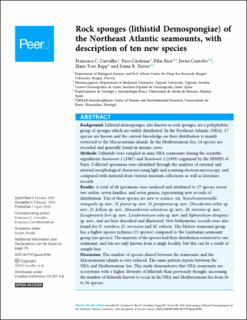| dc.description.abstract | Background
Lithistid demosponges, also known as rock sponges, are a polyphyletic group of sponges which are widely distributed. In the Northeast Atlantic (NEA), 17 species are known and the current knowledge on their distribution is mainly restricted to the Macaronesian islands. In the Mediterranean Sea, 14 species are recorded and generally found in marine caves.
Methods
Lithistids were sampled in nine NEA seamounts during the scientific expeditions Seamount 1 (1987) and Seamount 2 (1993) organized by the MNHN of Paris. Collected specimens were identified through the analyses of external and internal morphological characters using light and scanning electron microscopy, and compared with material from various museum collections as well as literature records.
Results
A total of 68 specimens were analysed and attributed to 17 species across two orders, seven families, and seven genera, representing new records of distribution. Ten of these species are new to science, viz. Neoschrammeniella inaequalis sp. nov., N. piserai sp. nov., N. pomponiae sp. nov., Discodermia arbor sp. nov., D. kellyae sp. nov., Macandrewia schusterae sp. nov., M. minima sp. nov., Exsuperantia levii sp. nov., Leiodermatium tuba sp. nov. and Siphonidium elongatus sp. nov., and are here described and illustrated. New bathymetric records were also found for D. ramifera, D. verrucosa and M. robusta. The Meteor seamount group has a higher species richness (15 species) compared to the Lusitanian seamount group (six species). The majority of the species had their distribution restricted to one seamount, and ten are only known from a single locality, but this can be a result of sample bias.
Discussion
The number of species shared between the seamounts and the Macaronesian islands is very reduced. The same pattern repeats between the NEA and Mediterranean Sea. This study demonstrates that NEA seamounts are ecosystems with a higher diversity of lithistids than previously thought, increasing the number of lithistids known to occur in the NEA and Mediterranean Sea from 26 to 36 species. | en_US |

